Methods and compositions for killing of insect pest eggs
a technology for insect pests and compositions, applied in the field of compositions and methods for the control of insect pest eggs, can solve the problems of ongoing problems in the control of insect pests
- Summary
- Abstract
- Description
- Claims
- Application Information
AI Technical Summary
Benefits of technology
Problems solved by technology
Method used
Image
Examples
example 1
Killing Body Lice Eggs
[0077]Small, roughly equal-sized body lice nit swatches (25 to 100 eggs / replicate) were dipped into treatment solutions for five seconds using forceps. The treatments included 100% ethanol and a 15% solution of 2-undecanone (NC0728). The experiments included a no treatment control. The treated and control swatches were maintained at 27° C. and relative humidity of 76% in an insectary for duration of experiment. The number of lice that emerged were counted after 24 hours and 45 hours, with the count being cumulative over 45 hours total. The results are shown in FIGS. 1A-1B. One louse died in the ethanol treatment.
example 2
Killing Insect Eggs Using a Cotton Bollworm Model System
[0078]Newly oviposited eggs of the cotton bollworm were used as model insect eggs to examine the synergism between 2-undecanone and DE from a commercial source (Sigma, DE with no insecticidal activity). Due to their obligate parasitic lifestyle, lice, head lice, in particular, are very difficult to obtain. Thus, bollworm eggs were used in place of lice eggs for the experiments showing efficacy of the treatments described herein. Notably, bollworm eggs are understood to be more robust than lice eggs as a result of their method of deposition on leaves, which requires that they survive direct sunlight, wind, rain, predation and parasites. Therefore, it is understood that if the treatment works on bollworm eggs, it will also work on the eggs of head lice. Further, the experiments using body lice, a recognized proxy for head lice, confirmed the effectiveness of the treatment with the formulations of this invention.
[0079]All treatmen...
example 3
Synergistic Effect of 2-undecanone and DE on Bollworm Egg Hatching
[0082]Sheets were cut with approximately 25 bollworm eggs per sheet. Three replicates of two solutions were tested: (1) 1% 2-undecanone in ethanol or (2) 1% 2-undecanone / 1% DE (Thomas Labs DE) in ethanol.
[0083]Eggs were dipped in solutions for 1 second and allowed to dry for 10 minutes at room temperature before being placed in sealed petri dishes. Eggs were stored at 76 ° F. and hatching monitored every 24 hours for 4 days. The results are shown in FIG. 3.
[0084]FIG. 3 shows the synergism between 1% 2-undecanone and DE as the 2-undecanone with DE was much more effective at reducing egg hatching when compared to 1% undecanone alone.
PUM
 Login to View More
Login to View More Abstract
Description
Claims
Application Information
 Login to View More
Login to View More - R&D
- Intellectual Property
- Life Sciences
- Materials
- Tech Scout
- Unparalleled Data Quality
- Higher Quality Content
- 60% Fewer Hallucinations
Browse by: Latest US Patents, China's latest patents, Technical Efficacy Thesaurus, Application Domain, Technology Topic, Popular Technical Reports.
© 2025 PatSnap. All rights reserved.Legal|Privacy policy|Modern Slavery Act Transparency Statement|Sitemap|About US| Contact US: help@patsnap.com



